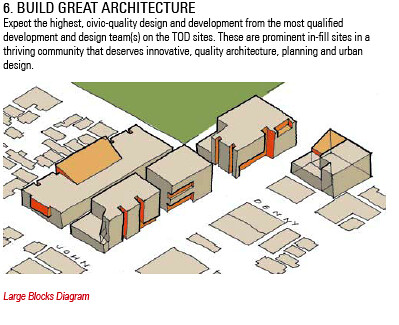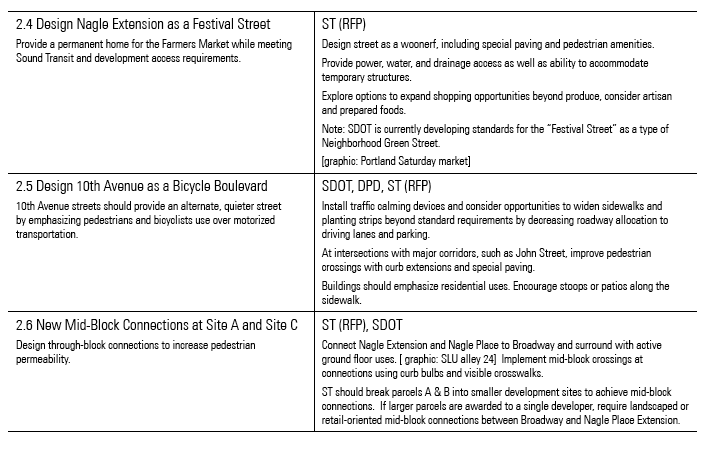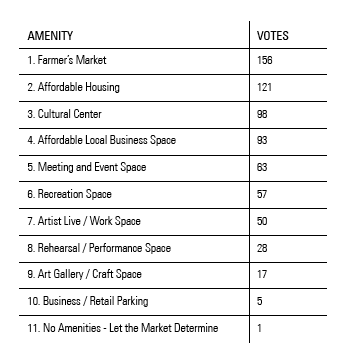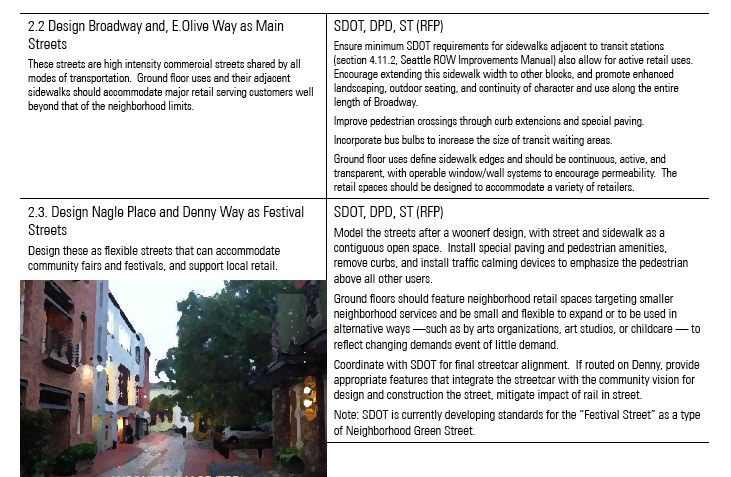
The community work group helping to represent Capitol Hill’s needs as Sound Transit puts together its plan for ‘transit oriented development’ at the Capitol Hill light rail station has released a draft set of recommendations for the project. Based on feedback from discussions and exercises in September’s Broadway Design Charrette, the 38-page report is an attempt to shape the community’s influence on Sound Transit’s development process. You can review the entire draft report at the end of the post. Here are some highlights and notes. The working group meets today to discuss the draft. We’ll pass along any feedback collected here to the group which includes officials from Sound Transit, Seattle University, Seattle Central, the Capitol Hill Community Council and Chamber of Commerce, and, yes, even CHS. Here’s past CHS coverage about how Sound Transit is planning to develop the light rail station. Also, don’t forget about Thursday’s Sound Transit Construction Update meeting at Seattle Central.
First, here is the draft set of goals for the report:
By 2016, a substantial amount of public investment will have occurred around the Sound Transit Capitol Hill Station sites, most notably through Sound Transit’s completion of the University Link, the already completed building of Cal Anderson Park, and the future completion of the First Hill Street Car line. The value of these investments was demonstrated in 2009, when Sound Transit’s just completed Central Link Light Rail line was commended for design excellence as one of Seattle’s Top 5 public projects and Cal Anderson Park was recognized as one of the Top 12 public parks in the country. The near future promises continued public investment, with the First Hill Streetcar’s anticipated ground breaking in 2011 and its full operations by 2013. Due in part to these public investments and the enhanced quality of life they herald, Capitol Hill continues to attract many new (mostly local) businesses and boasts some of the lowest residential vacancies in the city – all despite the challenging economic climate of 2009.
Goals:
• Supplement/Clarify existing development regulations, plans, and design guidelines that already affect the ST-parcels and the Station Area Overlay (SAO).
• Influence Sound Transit’s transit oriented development planning and specifically their crafting of the developer request for qualifications/proposal (RFQ/RFP) planned for 2012 / 2013.
• Guide future neighborhood and/or station area planning efforts as well as urban design, infrastructure, or transportation improvements planned for the station area and beyond.
For you executive types, here’s a summary of the recommendations:
EXECUTIVE SUMMARY OF THE COMMUNITY DEVELOPMENT GOALS
Based upon the information gathered in the charrette and associated outreach, the development of the Sound Transit parcels should include:
Development Projects of the Highest Quality
Due their central location and adjacency to several Capitol Hill landmarks, there was unanimous support for the highest quality development on the TOD sites.A Permanent Home for the Farmer’s Market
Provide a permanent home for the popular Capitol Hill Farmer’s Market on either Nagle Place or Denny Street by making them either low-traffic streets with enhanced sidewalks and pedestrian amenities (for Denny) or a woonerf (for Nagle).Affordable Housing and Business Space
Capitol Hill has some of the highest real estate prices in Seattle; therefore, incorporate affordable housing and affordable local business space.A Cultural Center and Community Spaces
A cultural center and space for community activity is currently lacking on Capitol Hill. Providing such spaces – including a dedicated space for the LGBT community – is desired.A Gateway and Neighborhood Wayfinding
Given their geographically central locations on Capitol Hill, the TOD sites are at the intersection of many popular pedestrian routes as well as the future street car line, current bus routes, and future Sound Transit station. The TOD sites should accommodate and enhance these connections as well as provide a gateway and aid in route finding around Capitol Hill.Environmentally Responsible Building Practices
Low impact site development and sustainable design and construction measures should be incorporated in all development.Selective Additional Height
Given the immediate adjacency to the Sound Transit stations, there was limited support for increasing currently allowable building height as an option to incorporating desired community goals.Low Ratio Parking
In acknowledgment of TOD best practices, as well as reflecting its location in a high density neighborhood, lower than typical market-dictated parking ratios are desirable.
Here are some of the specific actions the group is recommending to achieve all of this. Particularly interesting are the recommendations for how specific streets in the area should be planned for as the development effort takes shape:
 The report also has results from a vote you might have participated in at various community events late last summer. Using pennies and jars, community members cast their vote for which development elements they most supported by dropping their allotted three coins into jars representing the following. People love the farmers’ market. Good thing there’s a plan for it.
The report also has results from a vote you might have participated in at various community events late last summer. Using pennies and jars, community members cast their vote for which development elements they most supported by dropping their allotted three coins into jars representing the following. People love the farmers’ market. Good thing there’s a plan for it.
 The report also includes recommendations for everything from how to work with existing community organizations to achieve some of the community use priorities above, to investing in the maintenance and improvement of Broadway, to how to manage parking around the development. Here’s the entire draft report:
The report also includes recommendations for everything from how to work with existing community organizations to achieve some of the community use priorities above, to investing in the maintenance and improvement of Broadway, to how to manage parking around the development. Here’s the entire draft report:




awesome…love the mid-block crosswalk idea
justin, thanks for making this document and the summary findings so accessible. it is key to having as much community participation as possible. go CHS.
This work is awesome! I love Capitol Hill because we are a home for everyone regardless of income or background. I love that we support affordable housing.
In addition to supporting non-profits to build affordable housing on or near the site, perhaps we could take a stronger approach than the city’s current Incentive Zoning structure. The current program would produce only a handful of affordable apartments in the area. It could be strengthened to require any new development in the area to include a percentage of affordable housing while allowing a little more density to offset the lost profit from the affordable spaces.
Capitol Hill seems like right neighborhood to take a more deliberate approach to maintaining our economic diversity.
Is that what “great architecture” looks like?
I hope the desire for ‘great architecture’ means something more than the cookie-cutter building that have been designed on the north end of Broadway or South Lake Union. Those buildings are such a disappointment to me. They are ugly to look at from the street level and since they are built practically to the edge of the sidewalk, they make it rather claustrophobic to walk past them. Buildings in this area should be a joy to walk by, enhancing the neighborhood, instead of trying to be efficient and use up all the space in the name of economics. Tell the designers to go take a walk through the Pearl District of Portland, or walk around up in Vancouver. Why must these horrible things be built this way? Set them back from the sidewalk, add some benches/sitting areas–or just some freakin’ landscaping???
Anyone have any additional comments that they would like to see incorporated into the report?
In response to the limited comments here, “great architecture” (as we suggest it is defined) is a built environment that contributes to a thriving and vital civic/pedestrian realm, using high-quality materials and design worthy of such a prominent site in our community. Capitol Hill Design Review Guidelines get into the details, but will need to be refined to ensure that we get much higher-quality projects than what we’re currently seeing on Broadway. And the community (you) will need to attend the Design Review meetings to help influence the process as well. Thanks everyone for your time.